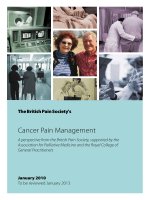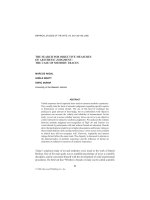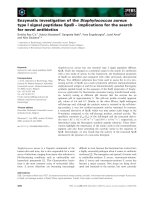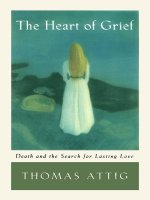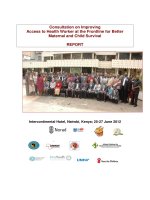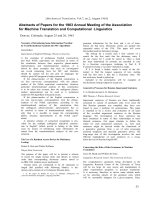- Trang chủ >>
- Mầm non - Tiểu học >>
- Lớp 5
5 8 the search for land, gold, and a new life
Bạn đang xem bản rút gọn của tài liệu. Xem và tải ngay bản đầy đủ của tài liệu tại đây (5.07 MB, 10 trang )
The Search
for Land, Gold,
and a New Life
Fascinating Facts
• Nearly $2 billion in gold was mined in California
before widespread mining stopped.
• Besides California, gold rushes occurred in Australia
(1851), British Columbia (1858), Nevada (1859–60),
Colorado (1850s and 1890s), South Dakota (1876–78),
and South Africa (1886).
• The word touchstone means a test that shows if
something is real. The original touchstone was a
black stone that, when rubbed with a piece of gold,
showed if the gold was pure.
Genre
Nonfiction
Comprehension Skill
Compare
and Contrast
Text Features
• Sidebars
• Captions
• Song
Scott Foresman Social Studies
ISBN 0-328-14898-9
ì<(sk$m)=beijib< +^-Ä-U-Ä-U
by Cynthia Clampitt
People had different reasons for coming to the United
States: escaping poverty, looking for adventure, and
dreaming of freedom. As the United States expanded
its territory, people flooded into the areas that they
thought held the promise of a new life. In this book you
will read about the people who crossed the sea or the
prairies, what they were looking for, and what they found
as the United States continued to grow.
Write to It!
The Search
for Land, Gold,
and a New Life
Select a person or topic mentioned in this book, then
find additional facts—ones not included in this book—
about the person or topic. You may use the library, an
encyclopedia, or the Internet for your research. Write
two or more paragraphs about what you discover.
Write your paragraphs on a separate sheet of paper.
Vocabulary
manifest destiny
blaze
mountain men
wagon train
annex
gold rush
prospector
forty-niner
by Cynthia Clampitt
Photographs
Every effort has been made to secure permission and provide appropriate credit for photographic material. The publisher deeply
regrets any omission and pledges to correct errors called to its attention in subsequent editions.
Unless otherwise acknowledged, all photographs are the property of Scott Foresman, a division of Pearson Education.
ISBN: 0-328-14898-9
Photo locators denoted as follows: Top (T), Center (C), Bottom (B), Left (L), Right (R) Background (Bkgd)
Copyright © Pearson Education, Inc.
All Rights Reserved. Printed in the United States of America. This publication is protected
by Copyright, and permission should be obtained from the publisher prior to any prohibited
reproduction, storage in a retrieval system, or transmission in any form by any means,
electronic, mechanical, photocopying, recording, or likewise. For information regarding
permission(s), write to: Permissions Department, Scott Foresman, 1900 East Lake Avenue,
Glenview, Illinois 60025.
Opener: ©Corbis
3 ©James Randklev/Stone/Getty
Images Needham, Massachusetts • Duluth, Georgia
Sales Offices:
4 ©Bridgeman Art Library
Coppell,
Texas • Sacramento, California • Mesa, Arizona
5 ©Bettmann/Corbis
6 ©Corbis
8 ©Bettmann/Corbis
10 ©Bettmann/Corbis
12 ©Getty Images
15 ©Bettmann/Corbis
1 2 3 4 5 6 7 8 9 10 V0G1 14 13 12 11 10 09 08 07 06 05
Editorial Offices: Glenview, Illinois • Parsippany, New Jersey • New York, New York
• Glenview, Illinois
More Land, More People
Opening Up the West
In the 1800s the United States was growing. People continued
to arrive from other lands, but more than just the population
was expanding. The size of the country also increased as more
territories were gained. By 1850 the United States stretched
from the Atlantic Ocean to the Pacific Ocean.
Many people had come to the United States to escape poverty
in Europe, only to find themselves still trapped in poverty in the
cities of the eastern United States. They dreamed of having
farms and building homes. Others dreamed of finding gold—a
less reliable dream than farming, but possibly a quicker road to
prosperity. Following these dreams changed people’s lives and
the United States.
The country’s growth was caused by more than dreams,
however. Many Americans had begun to believe it was the
nation’s manifest destiny to grow. More land meant greater
strength for the country and fewer borders to protect. It
meant more opportunities for the poor and the immigrants
who continued to arrive. Also, part of the West was a land
of freedom for escaped enslaved people. The West had
to be opened up—hundreds of thousands of people were
depending on it.
Unfortunately, this expansion had a cost. American
Indians were often pushed aside as newcomers laid claim
to traditional land or gold miners took over waterways. Also,
thousands of people died on the trails or during conflicts.
However, these hardships did not stop people’s dreams and
hopes that the United States should grow and that anyone
could succeed here.
Before people could head west, the land had to be explored
and trails had to be blazed, or marked. It was the mountain men
who opened up the West. The mountain men were fur trappers,
traders, and scouts. They made the unexplored regions their home.
They blazed the great western trails and created interest in this
new land with their stories of vast forests and fertile valleys.
Mountain man John Colter traveled with Lewis and Clark before
becoming a trapper and scout. He traveled on foot through the
mountains in the area that is now Montana, Idaho, and Wyoming.
In 1807 he became the first American to see the area American
Indians called Yellowstone. His tales of boiling mud and geysers
shooting into the air were not believed. People thought he had
lost his mind.
No one believed John Colter when he described
the geysers and other sights of Yellowstone.
2
3
Jedediah Smith, shown here leading a party of trappers through the desert, is
considered by many to have been one of the greatest of the mountain men.
Jedediah Smith was part of a group that opened a passage to
the Northwest in 1824. In 1826 Smith found a westward route
to California. He and the traders he was leading became the first
Americans to enter California from the east. Smith was also
the first American to reach present-day Oregon by traveling up the
Pacific coast.
Smith’s adventures were often dangerous. He nearly died of
thirst in the desert, and he was almost killed by a grizzly bear.
He survived several attacks by American Indians, but was finally
killed by the Comanche in the Southwest.
Jim Bridger’s name lives on in the Bridger Range in Montana,
Bridger Pass in southern Wyoming, and Bridger-Teton National
Forest in western Wyoming. Bridger explored the territory ranging
from the Canadian border to New Mexico.
4
Jim Beckwourth was the son of an enslaved African American
woman. He headed west when he was given his freedom. A pass
he found through the Sierra Nevada later became part of the
overland trail to California.
Kit Carson was a mountain man who became a folk hero.
Carson joined a group of trappers and frontiersmen while he
was still a teenager. He became a scout for the United States
military. In 1854 he was appointed to be an American Indian
agent and became well known for his fairness and sympathy for
the problems faced by American Indians.
The days of the mountain men were over by about 1850. By
this time the West had been opened up. Trails had been blazed
to Oregon and California, and people who were not explorers were
now heading west.
Jim Beckwourth, the son
of an enslaved person, enjoyed
the freedom of being a
mountain man.
Settling the Pacific Northwest
John Jacob Astor thought that opening a trading post in the
Pacific Northwest would increase his business. He bought furs
and shipped them to Asia, where there was a great demand for
them. He opened his trading post in 1811 at the mouth of the
Columbia River. The British, however, controlled most of the fur
trade in the region, and his trading post failed.
Increased activity by British fur traders worried the United
States government. However, in 1818 the two countries agreed
to share the part of the Northwest known as Oregon Country.
This area included all of present-day Oregon, Washington, and
Idaho, and parts of Montana, Wyoming, and British Columbia. In
1819 the United States and Spain signed a treaty setting Oregon’s
southern border, and Spain agreed not to settle Oregon.
Many settlers went west including Marcus Whitman, a young
doctor, and his wife, Narcissa Prentice Whitman. In 1836 the
Whitmans set up a mission near present-day Walla Walla,
Washington. They taught the Cayuse how to build houses, plow
fields, irrigate crops, and build mills to grind corn and wheat.
Narcissa started a school for local children. Dr. Whitman cared
for the Cayuse as well as missionaries and other people in
the region.
In 1842 the Whitmans learned that their assignment was going
to end. Marcus Whitman made a three-thousand-mile journey on
horseback to Boston to ask that their work be continued. He
also traveled to Washington, D.C., to ask federal officials to
encourage settlement in Oregon.
As Whitman returned to Oregon Country in 1843, he joined
a group of nearly one thousand immigrants who were headed
west. He guided their wagon train across the country, and it
was because of his efforts that they succeeded in crossing the
mountains to the Columbia River. This event became known as
the “great migration.”
This great migration convinced many people that the Oregon
Trail was safe. By the mid-1840s, six thousand settlers had
moved to Oregon Country.
Crossing the United States by wagon was not
easy. Mountains and rivers were among the many
difficulties that settlers faced heading west.
7
The Whitman Massacre
With so many people moving to the region, the United States
and Great Britain reconsidered their agreement about Oregon
Country. The British suggested that the northern border of Oregon
be set at the same latitude as the rest of the United States and
the Canadian border.
This decision encouraged many more Americans to move west.
Wagon trains of as many as one hundred covered wagons were
soon crossing the continent. Families loaded all their possessions
into these wagons before leaving on the two-thousand-mile journey,
which could take between four and six months to complete.
In 1847 there was a severe outbreak of measles that affected
both American Indians and settlers. Dr. Whitman cared for
many sick children. Unlike many of the settlers’ children, who
recovered, many American Indian children had no immunity to
the disease and died. The Cayuse were angry and believed that
the Whitmans were intentionally killing their children to make
room for more settlers. On November 29, 1847, the Cayuse
attacked, killing Marcus and Narcissa Whitman and twelve
other settlers, and kidnapping fifty-three women and children.
The Whitman Massacre, as it was called, led to the United States
government deciding to create the Oregon Territory, with a local
government and soldiers to protect its citizens.
Entire families, including children, traveled in the wagon trains.
People had to bring their pets and farm animals with them.
While on the Oregon Trail—the trail that led from Independence,
Missouri, to Oregon Country—people usually kept a regular
schedule. They rose at 4 A.M. and departed by 7 A.M. The wagon
train would travel until 4 P.M., and then would stop so the travelers
could prepare meals, make repairs, and feed their horses and
cattle. Children could play once their chores were done, and
violins or guitars were sometimes brought out to provide
entertainment.
Mountains and rivers were difficult to cross. Thunderstorms,
strong winds, and snow could make traveling even more difficult
and dangerous. Contaminated water or food often caused sickness.
Many people died, but the promise of a new life and the possibility
of escaping poverty made people push onward.
During the 1840s about twelve thousand people used the
Oregon Trail to reach the Pacific Northwest. Of all the great overland
routes to the West, the Oregon Trail was used the longest.
8
9
A Difficult Time for Mexico
The 1800s were a time of disorder and uncertainty in Mexico.
In 1821 an army led by Agustín de Iturbide (ah gus TEEN day ee ter
BEE day) and Vincente Guerrero (vin CHEN tay ger AIR oh) took
control of most of Mexico. Spain sent a new military governor, but
it was too late to regain control. A treaty was signed on August
24, 1821, that gave Mexico its independence from Spain.
Iturbide crowned himself emperor of Mexico in 1822, and the
United States gave formal recognition to the Mexican empire. The
military, headed by Antonio López de Santa Anna, revolted against
the emperor in 1823. Iturbide was forced from power, and in 1824
he was arrested and shot.
Santa Anna surrenders to Sam Houston, who was wounded in
the Battle of San Jacinto.
10
Santa Anna declared that Mexico was now a republic. Men
were given the right to vote, but government protections were
removed for native peoples, who were now worse off than under
Spanish rule. Different military groups fought for control, and the
government changed hands every year or two. Mexico’s debts
skyrocketed.
In 1833 Santa Anna again took control of Mexico’s government,
this time as president. Santa Anna adopted a new constitution in
1836, one that eliminated states’ rights. The people most affected
by this were the thirty thousand United States immigrants who
had settled in the Mexican-held area known as Texas. When
the Texans revolted, Santa Anna crushed the first group he
encountered at the Alamo in February 1836. Santa Anna’s army
was then defeated by Sam Houston’s troops in April 1836, and
Santa Anna was captured.
In exchange for his freedom, Santa Anna promised not to try
to recapture Texas. However, he refused to recognize Texas’
independence. When the United States annexed Texas in 1845,
the Mexican people removed Santa Anna from power because he
had been willing to negotiate with the United States.
The two countries could not agree on the southern boundary of
Texas. President James Polk tried to make peace by offering $30
million to Mexico for New Mexico and California. Mexico needed the
money badly but refused.
United States troops who were protecting the southern border
of Texas were attacked by Mexican troops in April 1846. Polk
saw it as an act of war, and the Mexican War began. The war
lasted until February 1848. The treaty that ended the war gave
the United States a vast territory that included most of the
American Southwest. It also gave Mexico $15 million and granted
citizenship to the seventy-five thousand Mexicans living in the
Southwest.
11
California had never attracted large numbers of people. Much of
the state was dry, with little of the fertile land that drew farmers
to Oregon. It was mountainous and hard to reach. During the
Mexican War, Mexico had hardly bothered to defend California.
Now suddenly everyone wanted to go there. The gold rush was on.
As “gold fever” took hold, people left their homes and their jobs.
Stores and schools were closed, and farms were abandoned. In
one year, eighty thousand men flooded into California. Sutter’s
fears proved correct, and within a few months his land was covered
with tents and was being torn up by miners’ picks and shovels.
At the beginning of the gold rush, miners usually worked
on their own, panning in streams or digging nearby.
Going for the Gold
Chinese Immigration
In early 1848 a carpenter from New Jersey named James Wilson
Marshall picked up some yellow pebbles in a California stream.
The pebbles were gold! John Sutter, a rancher from Switzerland,
owned the land where the gold was found. Sutter knew that news of
the discovery could ruin everything he had built because people
would come by the thousands and overrun his land. He asked
his workers to tell no one, but the news leaked out anyway. There
were no telephones or telegraphs, so the news spread slowly
at first. One friend told another friend, and everyone who had
heard about it headed for Sutter’s land. By March 1848, several
newspapers had published the story of Marshall’s discovery. The
news electrified the country and sped around the world.
The Chinese name for California was “Gum Shan” or “Gold
Mountain.” News of the discovery of gold reached China in 1848,
and by 1852 twenty-five thousand Chinese had reached Gold
Mountain. As was true of American miners, only a few struck it
rich in the gold fields. Many of those who did strike gold returned
to China with their wealth. Of those who stayed, some continued
to mine. Many found work as cooks, farmers, and merchants.
Some opened stores or restaurants. The first Chinese laundry
opened in San Francisco in 1851, followed by many more.
Most Chinese immigrants had left mining by 1868. Many of
the former miners went on to help build the transcontinental
railroad.
12
13
The first prospectors, or people who came searching for gold,
were called forty-niners because they arrived in 1849. There were
prospectors of many different nationalities, and most of those who
arrived in 1849 were men. Life in the gold fields was not pleasant.
Most miners lived in small tents, and there were few services such
as doctors or barbers. Without any laws, government, or police,
mining camps were often dangerous places. Few people wanted
to expose wives or daughters to these hardships—though a few
women did make the trip, and some even came to search for gold.
Life was also hard for the region’s American Indians. Some
joined the rush for gold, but many were driven off by hostile
prospectors. Those who stayed found their lands and waterways
ruined as digging continued. Californios, the Hispanics who lived
in California before it became part of the United States, also found
their land overrun. Losing their land and livelihood would create
problems for the Californios for decades after the gold rush ended.
Darling Clementine
One of the best-known songs about the gold rush is
“Clementine.” In it a miner sings about his daughter who
drowned. He could not save her because he could not swim.
In a cavern, in a canyon,
Excavating [digging] for a mine
Lived a miner forty-niner
And his daughter, Clementine.
Oh my darling, oh my darling,
Oh my darling Clementine,
You are lost and gone forever,
Dreadful sorry, Clementine.
14
Immigrants, Hispanic Californios, and American Indians
often worked together, at least when gold was plentiful.
By 1853 a total of 250,000 fortune-seekers had arrived in
California, which had become a state in 1850. By that time, many
prospectors had left for the big gold rush in Australia in 1851.
Many people who were disappointed by their lack of success
moved back east. However, California continued to grow as
settlers replaced the miners. The gold rush was over, but
California was just getting started.
15
People had different reasons for coming to the United
States: escaping poverty, looking for adventure, and
dreaming of freedom. As the United States expanded
Glossary
its territory, people flooded into the areas that they
annex to add or attach
thought held the promise of a new life. In this book you
blaze
to mark
trail,people
especially
cuttingthe
offsea
a piece
of
will read
abouta the
who by
crossed
or the
tree bark
prairies,
what they were looking for, and what they found
as the United
States continued
to grow.
forty-niner
a nickname
for a person
who arrived in
California in 1849 to look for gold
Write to It!
Select a person or topic mentioned in this book, then
find additional facts—ones not included in this book—
about the person or topic. You may use the library, an
encyclopedia, or the Internet for your research. Write
two or more paragraphs about what you discover.
Write your paragraphs on a separate sheet of paper.
gold rush the suddenVocabulary
movement of people to an area
where gold has been found
manifest destiny
manifest destiny the belief that the United States should
blaze
expand west to the Pacific Ocean
mountain men
mountain men scouts, fur trappers, and traders who
wagon
train
opened up the American
West
to westward settlement
in the 1800s
annex
prospector a person who
explores
gold
rush or examines a region,
searching for gold or other valuable resources
prospector
wagon train a common method of transportation to the
forty-niner
West, in which wagons
traveled in groups for safety
Photographs
Every effort has been made to secure permission and provide appropriate credit for photographic material. The publisher deeply
regrets any omission and pledges to correct errors called to its attention in subsequent editions.
Unless otherwise acknowledged, all photographs are the property of Scott Foresman, a division of Pearson Education.
ISBN: 0-328-14898-9
Photo locators denoted as follows: Top (T), Center (C), Bottom (B), Left (L), Right (R) Background (Bkgd)
Copyright © Pearson Education, Inc.
All Rights Reserved. Printed in the United States of America. This publication is protected
by Copyright, and permission should be obtained from the publisher prior to any prohibited
reproduction, storage in a retrieval system, or transmission in any form by any means,
electronic, mechanical, photocopying, recording, or likewise. For information regarding
permission(s), write to: Permissions Department, Scott Foresman, 1900 East Lake Avenue,
Glenview, Illinois 60025.
Opener: ©Corbis
3 ©James Randklev/Stone/Getty Images
4 ©Bridgeman Art Library
5 ©Bettmann/Corbis
6 ©Corbis
8 ©Bettmann/Corbis
10 ©Bettmann/Corbis
12 ©Getty Images
15 ©Bettmann/Corbis
1 2 3 4 5 6 7 8 9 10 V0G1 14 13 12 11 10 09 08 07 06 05
16

